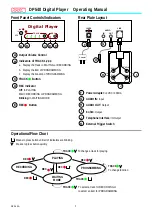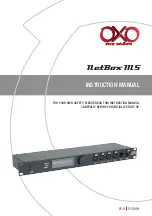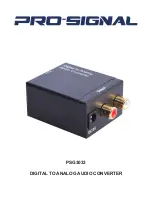
MS-SOUND-decoders MS440 to MS990 Page 21
CV
Denomination
Range
Default Description
tens digit = 1: Subsequent CV 100
= 2: ... + 200
etc. = 9: ... + 900
Hundreds digit = 0: Revaluation valid for one operation
= 1 ... to power-off
#65
SW
Sub-Version Number
Also see CV #7 for
Version number
Read only
-
If there are subversions to the SW version in CV #7, it
is read out in CV #65.
The entire SW version number is thus composed of
CVs #7 and #65 (i.e. 28.15).
#248,
#249
Bootloader
version and subversion Read only
-
Reading out these CVs provides the version and sub-
version of the bootloader currently on the decoder
(bootloader = program to load the actual software).
Decoders are usually delivered with default
address 3
(
CV #1 = 3
),
for DCC as well as the MM
(Märklin Motorola) format. With this address the decoder is fully functional but it is recommended to
change to a different address as soon as possible.
The address space required for DCC exceeds the range of a single CV, up to 10239 in fact. Addresses
higher than 127 are stored in CV #17 and #18. CV #29, Bit 5 is used to select between the short ad-
dress in CV #1 and the long address in CVs #17/#18.
Most digital systems (with the possible exception of very old or simple products) automatically calcu-
late the value for the CVs involved and also configure CV #29 Bit 5 to the proper value when writing
the address, so that the user does not have to deal with the necessary coding.
CV
Denomination
Range Default Description
#1
Locomotive address
DCC:
1 - 127
MM:
1 - 255
3
The “small” (or “short”) vehicle address (DCC, MM)
In case of DCC operation:
Primary address as per CV #1 is only valid, if
CV #29 (basic configuration), Bit 5 = 0.
Otherwise, the address per CVs #17 & #18 is valid,
i.e. if CV #29, Bit 5 = 1.
#15
+
#16
Decoder Lock
0 - 255
0 - 255
0
0
The decoder lock is used to access the CVs of several
decoder with identical address separately.
The CVs #16 of each decoder are programmed to differ-
ent values before installation. If necessary, the CV #15
of this decoder is reprogrammed to the value of "its" CV
#16 > all CVs addressable.
#17
+
#18
Extended (long) ad-
dress
1
-
10239
192
128
The long (“extended”) DCC address
applies to addresses >127.
The loco address per CVs #17 & #18 is valid, if
CV #29 (basic configuration), bit 5 = 1.
#29
Basic configuration
0 - 63
14 =
0000 1110
Bit 5 = 0
(“small”
Address)
Bit 0 - Train direction:
0 = normal, 1 = reversed
Bit 1 - Number of speed steps:
0 = 14, 1 = 28/128 speed steps
Bit 2 - automatic change to analog operation
0 = disabled 1 = enabled
Bit 3 - RailCom („bidirectional communication“)
0 = deactivated
1
= activated
CV
Denomination
Range
Default Description
Bit 4 - Individual speed table:
0 = off, CVs #2, #5 and #6 are active.
1 = on, according to CVs #67 – #94
Bit 5 - Decoder address selection:
0 = primary address as per CV #1
1 = “extended” address per CVs #17 & #18
Decoder-controlled consisting (a.k.a. “Advanced consisting” according to NMRA)
The combined operation (“consist”) of two or more locomotives (mostly coupled mechanically) with the
same speed can be managed by
- the digital system (common practice with ZIMO systems, without changing any CVs of the decoder) or
- by programming the following decoder CVs individually, or
the CVs are programmed automatically by the digital system (usually with American systems).
This chapter only covers the decoder-controlled consisting!
CV
Denomination
Range
Default Description
#19
Consist address
0, 1 – 127
129 - 255
( = 1 - 127
with
inverted direc-
tion)
0
Alternate loco address for consist function:
If CV #19 > 0: Speed and direction is governed by this
consist address (not the individual address in CV #1 or
#17&18); functions are controlled by either the consist
address or individual address, see CVs #21 & #22.
Bit 7 = 1: Driving direction reversed
#20
Extended
consist address
0 - 102
0
“Extended” consist address: the value defined in CV #20
is multiplied by 100 and added to the value in CV #19,
which then results in the address in consist operation.
E.g. CV #20 = 12, CV #19 = 34 equals addr. 1234;
CV #20 = 100, CV #19 = 00 equals addr. 10000
#21
Functions
F1 - F8
in consist operation
0 - 255
0
Functions so defined here will be controlled by the con-
sist address.
Bit 0 = 0: F1 controlled by individual address
= 1: …. by consist address
Bit 1 = 0: F2 controlled by individual address
= 1: …. by consist address
………. F3, F4, F5, F6, F7
Bit 7 = 0: F8 controlled by individual address
= 1: …. by consist address
#22
Functions
F0 forw. rev.
in consist function
and
0 - 255
0
Select whether the headlights are controlled by the con-
sist address or individual address.
Bit 0 = 0: F0 (forw.) controlled by individual address
= 1: …. by consist address
Bit 1 = 0: F0 (rev.) controlled by individual address
= 1: …. by consist address
















































